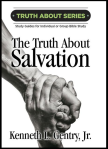QUICK NOTES ON THE RESURRECTION BODY

PMW 2023-036 by Kenneth L. Gentry, Jr.
Introduction
The physical resurrection of the dead is under attack in modern Christianity. Again. However, this time it is not just the liberals. Rather, some evangelical Christians themselves are denying the physical nature of the resurrection body. They often begin their denial by citing 1 Corinthians 15:44, which speaks of the resurrection body thus: “it is sown a natural body, it is raised a spiritual [pneumatikos] body. If there is a natural [pseuchikos] body, there is also a spiritual body [pneumatikos].” By misunderstanding this passage, the remainder of the Bible, and the power of God, opponents of the future, physical resurrection are, like Hymenaeus and Alexander: their faith is suffering shipwreck (1 Tim. 1:19–20; 2 Tim. 2:16–18).
This denial of the physical resurrection based on this famous passage is remarkable in that 1 Corinthians 15:44 has been in the NT for 2000 years. And during that time the universal, historic, orthodox Christian faith has held to a future physical resurrection. It even creedalized this great truth, which is “of first importance” regarding the gospel (1 Cor. 15:1–3). For instance, toward the end of the Apostles’ Creed we declare with the universal, historic, corporate Christian church that we believe “in the resurrection of the body and the life everlasting.” In the original language versions of the Creed, the resurrection of the “body” is more exactly declared to be the resurrection of the “flesh.” For in Latin the word carnis was used and in Greek sarx.
But there is abundant evidence in Scripture that the resurrection will be future, physical, and corporate. That is, it is not occurring now (for it is future). Nor is it a spiritual transaction (for it is physical). Nor does it transpire at the moment of each believer’s death, as they occur one-by-one (for it is corporate).
The Truth about Salvation By Ken Gentry
A study guide for personal or small group Bible study. Deals with the Christian doctrine of salvation from a Reformed theological perspective. It opens with a study of God as loving Creator, the shows how the first man fell into sin. Shows God’s righteousness requires that sin be dealt with. Presents Jesus as both God and man so that he can be man’s Savior. Includes review questions and questions for further study.Twelve chapters are ideal for one quarter of Sunday School.
See more study materials at: www.KennethGentry.com
Below I will present a succinct listing of some of the evidence for a future physical resurrection of the body Though my evidence is designed mostly to demonstrate the physical, corporeal nature of the resurrection, by doing such it will undercut any notion that it is happening today.
God’s Design for Man and Resurrection
By divine design, man is two-natured being composed of a unified body and soul (Gen. 2:7). In this he differs from angels who are spirits (Heb. 1:14). And the creation account declares that the physical creation of the world and of man was “very good” (Gen. 1:31), which shows that God would surely not discard it.
Old Testament Pointers and Resurrection
Resurrection is not just a New Testament issue. Many resurrections occur in the Bible — in both the Old (1 Kgs. 17:17–22; 2 Kgs. 4:18–37; 13:20) and the New Testaments (Mark 5:41; Luke 7:14; John 11:38–44; Matt. 27:52–53; Acts 9:36–42; 20:7–12). Each of these is clearly a physical resurrection that demonstrates God’s power (cp. Matt. 22:29; 1 Cor. 6:14). And serves as a pointer beyond themselves to the consummate eschatological resurrection For instance, when Jesus spoke of the deceased Lazarus rising again (John 11:23), his sister Martha immediately thought Jesus referred to the eschatological resurrection at the end (v. 24; which was the dominate view in first-century Judaism; see below). Then in response Jesus declares that he is the resurrection (anastasis, v. 25). In fact, several Old Testament passages present an eschatological resurrection, as we see in Job 19:25–27 and Isaiah 26:19.
God Gave Wine (by Ken Gentry)
A biblical defense of moderate alcohol consumption. Considers all key biblical passages and engages the leading objections.
See more study materials at: www.KennethGentry.com
First-century Judaism and Resurrection
The Pharisees believed in a physical resurrection (Acts 23:8), and Paul sided with them on this issue over against the Sadducees (Acts 23:6). In fact, “in classical Judaism, resurrection of the dead was a central belief, essential to defining oneself as a Jew” (Jon D. Levenson, Resurrection and the Restoration of Israel: The Ultimate Victory of the God of Life [Yale University Press, 2006]).
The Greek Word for “Resurrection”
The Greek word for “resurrection” is anastasis or anistemi, which means “stand up.” This refers to the body which has fallen down in death and will once again stand up in life — by resurrection. This will be just as Jesus rose again from the dead (John 20:9).
The Place of Resurrection
Thus, in John 5:28 the resurrection must involve the physical body for it occurs after death (not at the moment of death): at the tomb (John 5:25), that is, wherever the dead is resting. This passage also speaks of the resurrection as raising men from the tombs in a future, corporate action that involves both the righteous and unrighteous (John 5:28–29; cp. Acts 24:15; Rev. 20:13–15). It is not an ongoing action occurring at the moment when each individual dies.
The Necessity of Resurrection
Man in his full being exists as a body-soul complex. Thus, the unrighteous are necessarily judged in both body and soul in hell: “Do not fear those who kill the body but are unable to kill the soul; but rather fear Him who is able to destroy both soul and body in hell (Matt. 10:28). And for our part believers eagerly await “the redemption of our body” (Rom. 8:23).
Christ’s Physical Resurrection
Christ’s resurrection was physical (Luke 24:39; John 20:20, 27), leaving behind an empty tomb (John 20:1–2, 6–7). When Jesus was resurrected, it was his flesh (body) that was raised and which did not suffer decay (Acts 2:31–33). And his resurrection is deemed the “first fruits” of ours (1 Cor. 15:20, 23). The concept of “first fruits” is derived from the ancient practice of harvesting. The first fruits of a crop are of the same nature as the final, full harvest of the crop — except that they are first. The first fruit of corn does not produce wheat or barley. What is sown is that which is reaped (cf. Gal. 6:7). Consequently, Paul teaches that God “not only raised the Lord, but will also raise us up through His power” (1 Cor. 6:14), for “He who raised Christ Jesus from the dead will also give life to your mortal bodies through His Spirit who dwells in you” (Rom. 8:11).
The Jerusalem Saints’ Resurrection
When Jesus was resurrected, many bodies of the saints were raised from out of the tombs and were seen by many (Matt. 27:52–53). These were probably recently deceased saints, but the fact remains that these bodies were resurrected in celebration of Christ’s resurrection. And they point to our ultimate resurrection (see reference to “first fruits” above in this article). Theirs was not a part of the eschatological resurrection, so they would not have had transformed, imperishable bodies and would have died again later.
The Denial of Physical Resurrection
According to Christ, those who doubt a resurrection do not believe in the “power of God’ nor do they understand the Scriptures (Luke 22:29–32). They are like the pagan Athenians who mocked the resurrection idea (Acts 17:32), as well as the Corinthian heretics who doubted the resurrection (1 Cor. 15:8–19). And those who believe the resurrection is past are like Hymanaeus who jeopardize the faith of some (2 Tim. 2:16–18),
The “Spiritual” Body Resurrection
The “spiritual [pneumatikos] body” in 1 Corinthians (1 Cor. 15:44) is not a body made of spirit any more than a Coke bottle is a bottle made of Coke. Rather, it is a Spirit-filled, Spirit-dominated body. Similarly, the pneumatikos man (1 Cor. 2:14–15) is not an ethereal, physically intangible person, but one controlled by the Spirit. Because of the Spirit’s work and power in the resurrection, our bodies will possess new qualities making them imperishable, glorious, and powerful (1 Cor. 15:42–44). Thus, they are fitted for eternity where no more decay and death occur.
Conclusion
This quick survey of arguments sustains the view of historic Christianity regarding the future, corporate, physical resurrection. This is significant in that the physical resurrection lies at the very core of Christianity and its redemptive promise (1 Cor. 15:1–3). The universal Christian church has surely not been fundamentally wrong on one of its fundamental truths!

THE TWO AGES AND OLIVET (advertisement)
I am currently researching a study of the Two-Age structure of redemptive history. My starting point is based on the disciples’ questions to Jesus in Matthew 24:3. Much confusion reigns among those unacquainted with the Two-Age analysis of history, which was promoted by Jesus (Matt. 12:32; Mark 10:29-30) and by Paul (Gal. 1:4; Eph. 1:21). The Two Ages are not the old covenant and the new covenant, but world history since the fall and the consummate order following the Second Coming and the Final Judgment.
If you would like to support me in my research, I invite you to consider giving a tax-deductible contribution to my research and writing ministry: GoodBirth Ministries. Your help is much appreciated!
Kenneth L. Gentry Jr.'s Blog
- Kenneth L. Gentry Jr.'s profile
- 85 followers



